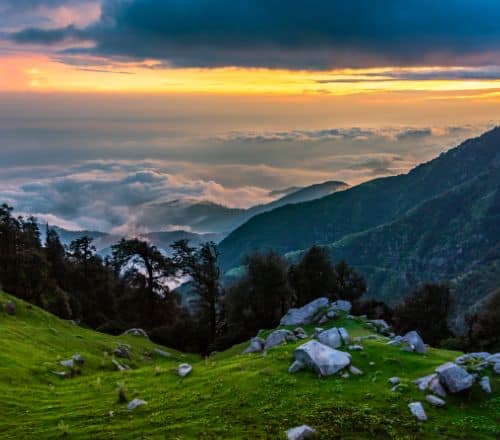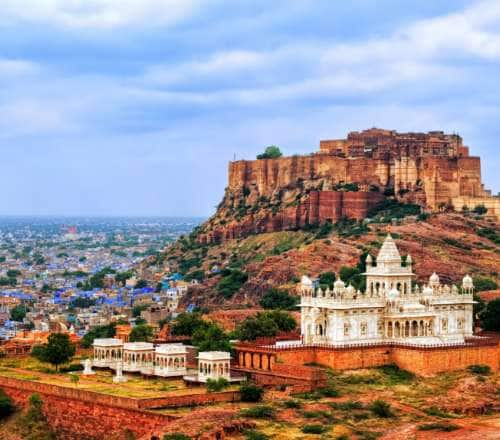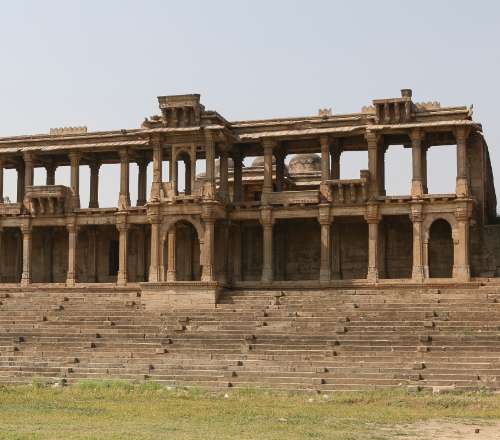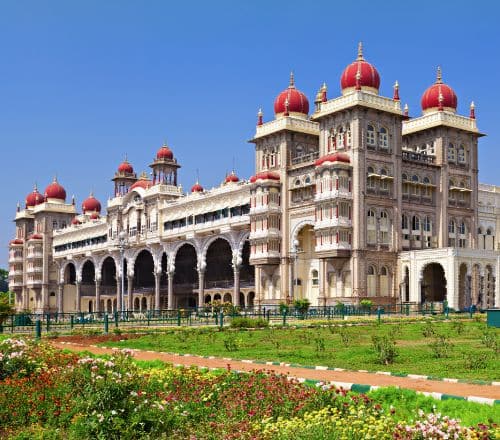Stay logged in to proceed with bookings, orders and offers.
On changing the terminal, you will loose items in your cart. Are you sure you want to change your terminal?
Abandoned for 300 years, this unique site tells its story through some brilliant specimens of Indo-Saracenic architecture
Was Lagaan filmed there?' the cinephile in me asked excitedly. Looking a little bored, my sexagenarian driver Patelji just shook his head. He'd probably heard this question before. But his answer didn't dampen my spirit.
I'd come to Ahmedabad alone on a work trip, and I hadn’t heard of Champaner and Pavagadh until Patelji mentioned the archaeological park. When I learned that a UNESCO World Heritage site spread across a gigantic 3280-acre area was just a 2.5-hour drive away, I didn’t have to think twice.
I'd always known in my heart that heritage sites had to be visited solo. Solitary exploration affords me the time to reflect, understand, and soak in the grandeur of bygone times.
I was thrilled at the idea of roaming through the archaeological park, amidst the ruins of Champaner fort, old mosques, ancient temples, and forgotten tombs. The relics were waiting to share their stories with those who would listen.
Read More
Read Less
Our first stop on the route to Champaner was a strange yet beautiful helical stepwell. The steps spiral down the wall, becoming narrower and narrower as they approach the bottom. A small misstep could prove very costly, and I held my breath as I ventured down the first few steps.
I learned that this 50 ft. deep well dates back to the 16th century. Gujarat has hundreds of stepwells of different shapes and sizes, but this is the only specimen of its kind. Speculate as I might, I simply couldn't understand the utility of such a design. As if to offer consolation, the helical stepwell is surrounded by a lush green garden.
Known as the 'Saher Ki Masjid' (Mosque of the City), this private mosque was built for the royal family and nobles of the Gujarat Sultanate. Its style is a resplendent fusion of Hindu and Islamic architectural elements, now often referred to as Indo-Saracenic architecture.
The mosque has five convex domes in total, with two vertical minarets flanking the central dome. This is also the entrance to a large prayer hall, characterized by rows of pillars reminiscent of temple mandapas. As opposed to the Hindu mandapas (pavilions), this structure catered to an exclusive audience of a select few, who were aristocrats and not commoners.
Not much remains of this eighth-century fort, except for its cavernous walls. 'See the view from over there,' said Patelji, pointing towards a raised platform. I obediently climbed the stairs, reaching the top of the wall. The panorama nearly knocked the wind out of me – it stretched as far as the eye could see, and I spent minutes marvelling at the beautiful landscape.
As the wind blew against the fort's crumbling facade, I wondered what this grand place had been like in its glorious past. It was a sobering feeling, walking amidst the ruins of a forgotten kingdom. A little overwhelmed, I turned my attention to a tablet detailing the fort's history.
Champaner was built by King Vanraj Chavda during the eighth century (CE). Under the reign of Khichi Rajputs, the city flourished until the 14th century. Islamic forces invaded Champaner in the mid-15th century, and after a prolonged siege that lasted 20 months, they successfully captured the fort. This was a watershed moment in the history of the state, as Islamic influences slowly seeped into a region that had been governed by Hindu royalty for over 650 years.
Champaner was invaded again by the Mughal Emperor Humayun in 1535 (CE). The incumbent Sultan was forced to retreat to Ahmedabad. However, the Mughal forces could not occupy the fort for long, as their influence across the central mainland began to wane. The once-flourishing city was abandoned and forgotten. Skip to 1879, British archaeologists rediscovered Champaner and began its conservation.
Now I understood the exquisitely fused Hindu and Muslim architectural elements I found all around me in Champaner.
A cursory glance at the Masjid's quaint medieval walls took my breath away, and I realized that everything about the ancient city of Champaner had to be savoured slowly. The sheer splendour of the structure in front of me was humbling, and a hushed feeling came over me. 'This is one of the finest mosques in Gujarat,' said Patelji. He spoke very little and was the perfect companion on my solo trip.
Jami Masjid is a colossal mosque in the Chamapaner-Pavagadh Archaeological Park. Dating back to 1508, the structure is built on a raised platform. Large minarets, domes and archways adorn the mosque. Its entrance is flanked by intricately filigreed walls.
I immediately noticed its resemblance to Saher Ki Masjid. 'The royal ladies used to pray from here while watching the proceedings in the main hall,' Patelji told me. Grazing the broken designs with my fingers, I couldn't help wondering about the lives and longings of the people who had stood here like me, aeons ago.
The shutterbug in me resurfaced as I felt a sudden urge to document my surroundings. Besides a huge octagonal tank by the Masjid was a beautiful spot offering a majestic view, and I set about snapping pictures.
There were two smaller mosques adjacent to the Jami Masjid, called the Kevda Masjid and Nagina Masjid. Both of these had beautiful cenotaphs. While the former bore imprints of a Graeco-Roman architectural style, the latter was adorned with Islamic artwork.
Let’s go, before it gets dark. The ropeway closes at 6:00 pm and weather at the top can be unpredictable,' said Patelji, seeing me loitering around the cenotaphs.
The sun had descended behind the hills some hours ago, leaving just a faint glow of light hovering above the silhouetted mountains.
Pavagadh Hills is the other part of the archaeological park. The vegetation is dense and the topography is characterised by many steep rock formations. On the way to the hilltop, we found an intriguing structure called 'Saat Kaman' (Seven Arcs) near the edge of a cliff. The spot offered a lovely aerial view of the Champaner town below. I could count only five arcs – but it was called Saat Kaman, and this baffled me.
Unlike the previous structures, I couldn’t find any signboards explaining the history of the place. 'No one knows why and who built this,' Patelji informed me. Mystified, I gazed at the elegant structure against the sylvan mountain background, until it was time to move on.
As the pathway became steeper, strong gusts accompanied by a cold fog engulfed the valley. Low-lying clouds drifted into the forested hills, giving everything a fairy-tale quality. Through the haze, we could see the Kalika Mata temple.
The Kalika Mata temple was built between the 10th and 11th centuries atop Pavagadh Hill. I was informed that the temple was both the pride and sanctuary of the erstwhile Hindu rulers, watched over by the Goddess Kalika – a deity from a heterodox Hindu cult.
The pathway ends at the small village of Machi. From here, another 250 steps along a steep incline lead to the cable car station. Understandably, Patelji wasn't very keen on climbing the steps.
The village had several shops selling trinkets and medallions. As I walked along these shops, mist surrounded the area. I could hardly see who was in front of me. The flickering lights of the shops, the nonchalant chatter of the pilgrims, and the sound of the temple bells in the distance – it all felt surreal.
The cable car is a short six-minute ride down the hill. It was dark and the feeble lights of the Champaner town flickered as I descended along the ropeway. It slowly began to drizzle, and I was bewitched by the aura of the place. I thought about the bustling town of Champaner, the valiant war with the invaders, the Islamic rulers who built several mosques with the help of Hindu artisans, and the subsequent abandonment of the site for more than three centuries. I wished I could travel back in time and see Champaner in all its glory – but perhaps this wistful longing was what I truly relished.
Best Time to Visit: Post-monsoons are the best time to go. The region will be very green.
Can Buy: The shops near the Kalika Mata Temple sell small, round steel rings which are believed to be sacred. They make an intriguing souvenir.
Must Try: The scenic drive to the top of Pavagadh Hill and the ropeway ride down the hill.
Where to Stay: Hotel Hill View, Greenland Resort, and the Champaner Heritage Resort are all within a 10-km. radius of Champaner. Prices go up from INR 3000.





The Adani One expressly disclaims all liability, direct and indirect, in respect to actions taken or not taken based on any or all the contents of this Blog. The Blog is an opinion of the contributor based on the collation of data from various sources and is provided only for information purpose. Adani One does not canvass, advertise, solicit, invite or induct for any product, merchandise, information, brand or any other materials mentioned in the Blog, nor does it obtain any monetary benefit from the same. Reader is advised to read and apply his/her intellect and discretion in this regard. Any Intellectual Property mentioned in this blog belongs to the rightful owner. We do not intent to claim any interest over the same.